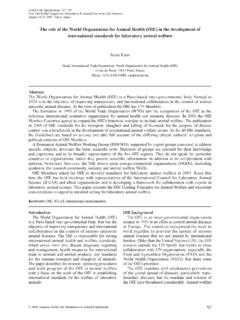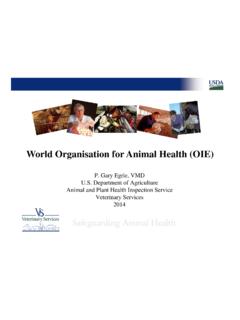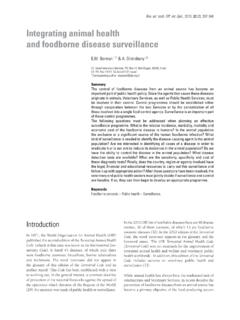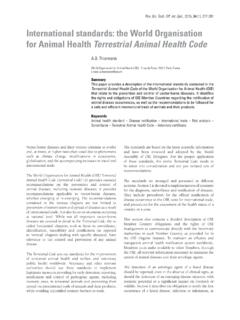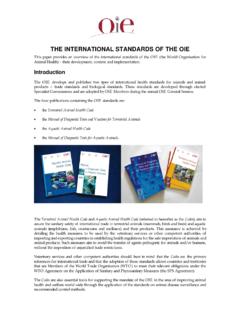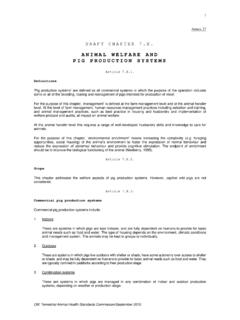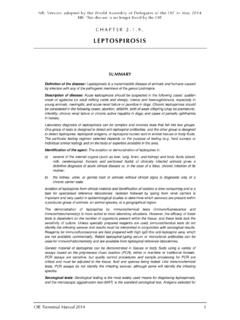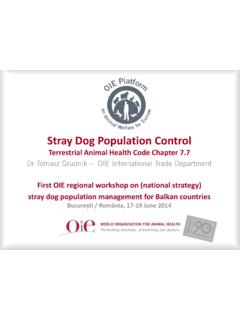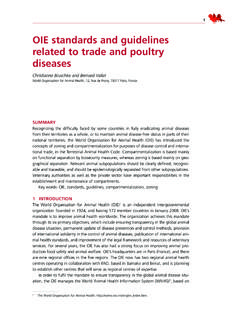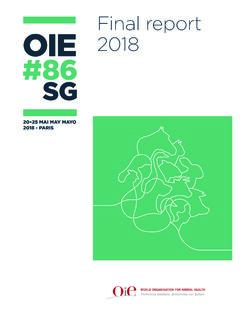Transcription of Terrestrial animal health status
1 EACHAPTER 2 Terrestrial animal health statusAustralia has a long history of freedom from the major epidemic diseases of livestock. The geographical isolation of the continent provides a natural biosecurity barrier, which is supported by sound biosecurity policies and a history of successful disease eradication spread of some endemic diseases in animals in Australia is limited by climate and the animal production enterprises present in a particular area. Tick fever, for example, occurs only in parts of northern Australia where the climate is suitable for the tick and territory governments manage the control and eradication of animal diseases, often with the support of industry accreditation schemes. Chapter 1 describes the coordinating mechanisms that are in place to provide national consistency for example, animal health Committee. This chapter provides information about Australia s reporting system for animal diseases, Australia s status for all nationally significant Terrestrial animal diseases, and control programs for endemic diseases of national significance in Terrestrial animal health status27 animal health in Australia 2015 NATIONAL NOTIFIABLE animal DISEASES The National List of Notifiable animal Diseases28 of Terrestrial animals facilitates disease reporting and control.
2 It takes into account key diseases on the list of diseases that are notifiable to the World Organisation for animal health (OIE) and also includes endemic diseases of national significance. Occurrences of diseases on this list must be reported to government authorities. This ensures that unusual incidents involving animal mortality or sickness and diseases of public health significance are investigated. The list is reviewed periodically by animal health Committee; it was last reviewed in early 2015. 28 requirement to report a notifiable disease is contained in state and territory legislation. State and territory lists of notifiable diseases contain all the diseases on the national list, as well as others that are of particular interest to an individual state or INTERNATIONAL REPORTING Australia provides the OIE with routine information about OIE-listed diseases through reports every six months. Information on other diseases of interest to the OIE is reported through annual questionnaires.
3 Tables and show Australia s status for both these categories in Australia s status for OIE-listed diseases of terrestrialDiseaseStatusDate of last occurrence and notesMultiple-species diseasesAnthraxPresentLimited distributionAujeszky s disease virus (infection with)FreeNever occurredBluetongueViruses presentRestricted to specific northern areas of Australia. Sentinel herd and vector monitoring programs are in placeBrucella abortus (infection with)FreeAustralia declared freedom in 1989 Brucella melitensis (infection with)Free Brucella suis (infection with)Serological evidenceMaintained in feral pigs in some parts of Australia. Rare occurrence in domestic pigs Crimean Congo haemorrhagic feverFreeNever occurredEchinococcus granulosus (infection with)Present Echinococcus multilocularis (infection with)FreeNever occurredEpizootic haemorrhagic diseaseVirus presentDisease has not been reportedEquine encephalomyelitis (eastern)FreeNever occurredFoot-and-mouth diseaseFree1872.
4 Australia is officially recognised by the OIE as free without vaccinationHeartwaterFreeNever occurredJapanese encephalitisSerological evidenceDetected annually in Torres Strait, and on Cape York in 1998 and 2004animals, 2015 Terrestrial animal health status29 Table Australia s status for OIE-listed diseases of Terrestrial DiseaseStatusDate of last occurrence and notesMultiple-species diseases continuedNew World screw-worm fly (Cochliomyia hominivorax)FreeNever occurredOld World screw-worm fly (Chrysomya bezziana)FreeNever occurredParatuberculosisPresentNational control and management programs are in placeQ feverPresent Rabies virus (infection with)Free1867 Rift Valley fever virus (infection with)FreeNever occurredRinderpest virus (infection with)Free1923. With the global eradication of rinderpest in 2011, all countries are freeSurra (Trypanosoma evansi)FreeNever occurredTrichinella spp. (infection with)Not reportedT.
5 Spiralis is not present. T. pseudospiralis is present in wildlifeTularaemiaFreeNever occurredWest Nile feverAustralian variants presentA previously unknown Australian strain of West Nile virus was identified following an outbreak of neurological disease in horses in 2011. No cases were reported in 2015 Cattle diseasesBovine anaplasmosisPresent Bovine babesiosisPresent Bovine genital campylobacteriosisPresent Bovine spongiform encephalopathyFreeNever occurred. The National Transmissible Spongiform Encephalopathies Freedom Assurance Program includes surveillance. Australia has official OIE negligible risk statusBovine tuberculosisFreeAustralia declared freedom in 1997. The last case in any species was reported in 2002 Bovine viral diarrhoeaPresentBovine viral diarrhoea virus 1 (BVDV-1) is present. BVDV-2 has never occurredEnzootic bovine leucosisVery low prevalence in beef cattleAustralian dairy herd achieved freedom on 31 December 2012 Haemorrhagic septicaemiaFreeNever occurred.
6 Strains of Pasteurella multocida are present, but not the 6b or 6e strains that cause haemorrhagic septicaemiaInfectious bovine rhinotracheitis/infectious pustular vulvovaginitisPresentBovine herpesvirus (BHV) present; and never occurredanimals, 2015 continuedAnimal health in Australia 2015 30 Table Australia s status for OIE-listed diseases of terrestrialDiseaseStatusDate of last occurrence and notesCattle diseases continuedLumpy skin diseaseFreeNever occurredMycoplasma mycoides subsp. mycoides small colony (contagious bovine pleuropneumonia) (infection with)Free1967. Australia declared freedom in 1973 and is officially recognised by the OIE as freeTheileriosisFreeTheileria parva and T. annulata are not presentTrichomonosisPresentTrypanosomosi s (tsetse borne)FreeNever occurredSheep and goat diseasesCaprine arthritis encephalitisPresentVoluntary accreditation schemes existChlamydophila abortus (enzootic abortion of ewes, ovine chlamydiosis) (infection with)Not reportedNever occurredContagious agalactiaNot reportedMycoplasma agalactiae has been isolated, but Australian strains do not produce agalactia in sheepContagious caprine pleuropneumoniaFreeNever occurredMaedi visnaFreeNever occurredNairobi sheep diseaseFreeNever occurredOvine epididymitis (Brucella ovis)PresentVoluntary accreditation schemes exist in all statesPeste des petits ruminants (infection with)FreeNever occurred.
7 Australia is officially recognised by the OIE as freeSalmonellosis (Salmonella Abortusovis)FreeNever occurred. Surveillance has shown no evidence of infection in sheepScrapieFree1952. The National Transmissible Spongiform Encephalopathies Freedom Assurance Program includes surveillance. Atypical scrapie has been detected several times Sheep pox and goat poxFreeNever occurredEquine diseasesAfrican horse sickness virus (infection with)FreeNever occurred. Australia is officially recognised by the OIE as freeContagious equine metritisFree1980 DourineFreeNever occurredEquid herpesvirus 1 (equine rhinopneumonitis) (infection with)Present Equine encephalomyelitis (western)FreeNever occurredEquine infectious anaemiaPresentLimited distribution and sporadic occurrenceanimals, 2015 continuedTerrestrial animal health status31 Table Australia s status for OIE-listed diseases of terrestrialDiseaseStatusDate of last occurrence and notesEquine diseases continuedEquine influenza virus (infection with)FreeAustralia s first outbreak occurred between 24 August and 25 December 2007.
8 Australia declared freedom according to OIE standards on 25 December 2008 Equine piroplasmosisFree1976 Equine viral arteritis (infection with)Serological evidence GlandersFree1891 Venezuelan equine encephalomyelitisFreeNever occurredSwine diseasesAfrican swine feverFreeNever occurredClassical swine fever virus (infection with)Free1962. Australia is officially recognised by the OIE as freeNipah virus encephalitisFreeNever occurredPorcine cysticercosisFreeNever occurredPorcine reproductive and respiratory syndromeFreeNever occurredTransmissible gastroenteritisFreeNever occurredAvian diseasesAvian chlamydiosisPresent Avian infectious bronchitisPresent Avian infectious laryngotracheitisPresent Avian mycoplasmosis (Mycoplasma gallisepticum)Present Avian mycoplasmosis (M. synoviae)Present Duck virus hepatitisFreeNever occurredFowl typhoidFree1952 Highly pathogenic avian influenza virus (infection with)Free2013 Infectious bursal disease (Gumboro disease)PresentInfectious bursal disease occurs in a mild form.
9 Very virulent strains are not presentLow pathogenicity notifiable avian influenza virus (poultry) (infection with)Occasional2013animals, 2015 continuedAnimal health in Australia 2015 32 Table Australia s status for OIE-listed diseases of Terrestrial DiseaseStatusDate of last occurrence and notesAvian diseases continuedNewcastle disease virus in poultry (infection with)Lentogenic viruses presentVirulent Newcastle disease last occurred in poultry in 2002. In August 2011, a paramyxovirus not previously reported in Australia was detected in hobby pigeons in Victoria. Disease caused by this virus has not spread to poultry Pullorum diseaseNot reportedLast reported in 1992. Salmonella Pullorum has been eradicated from commercial chicken flocksTurkey rhinotracheitisFreeNever occurredLagomorph diseasesMyxomatosisPresentUsed as a biological control agent for wild rabbitsRabbit haemorrhagic diseasePresentUsed as a biological control agent for wild rabbits.
10 A new strain was detected in 2015aBee diseasesAcarapis woodi (infestation of honey bees with)Free Never occurredPaenibacillus larvae (American foulbrood) (infection of honey bees with)Present Melissococcus plutonius (European foulbrood) (infection of honey bees with)PresentAethina tumida (small hive beetle) (infestation with)PresentRestricted distributionTropilaelaps spp. (infestation of honey bees with)FreeNever occurredVarroa spp. (varroosis) (infestation of honey bees with)FreeVarroa destructor has never been reported in AustraliaOther diseasesCamel poxFreeNever occurredLeishmaniasisAustralian variant presentRare. No Australian Leishmania was isolated from macropods in 2015. A case occurred in an imported dog in 2015 OIE = World Organisation for animal health a , 2015 continuedTerrestrial animal health status33 Table Australia s status for other diseases of Terrestrial DiseaseStatusDate of last occurrence and notesActinomycosisPresent Avian encephalomyelitisPresent Avian leucosisPresent Avian salmonellosis (excluding fowl typhoid and pullorum disease)Present Avian spirochaetosisPresent BlacklegPresent BotulismPresent Caseous lymphadenitisPresent CoccidiosisPresent Contagious ophthalmiaPresent Contagious pustular dermatitisPresent Distomatosis (liver fluke)PresentRestricted distributionEnterotoxaemiaPresent Equine coital exanthemaPresent FilariasisPresent FootrotPresentRestricted distributionInfectious coryzaPresent Intestinal Salmonella infectionsPresent ListeriosisPresent MelioidosisPresentRestricted distributionNosemosis of beesPresentSalmonellosis (Salmonella Abortusequi)

